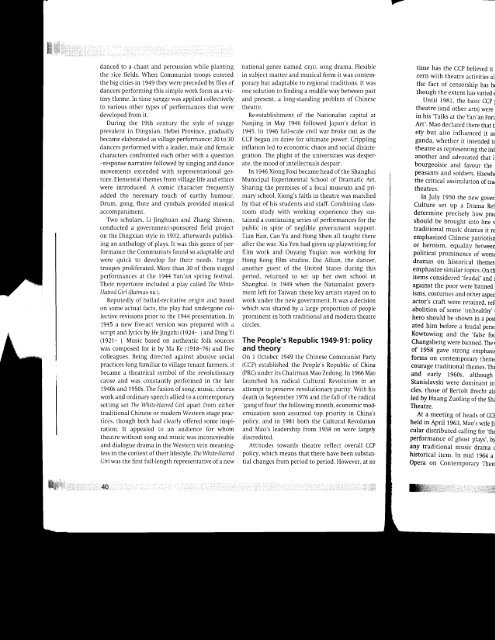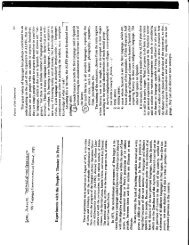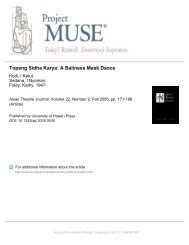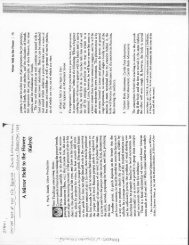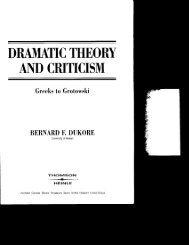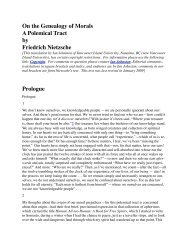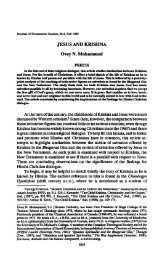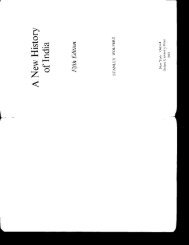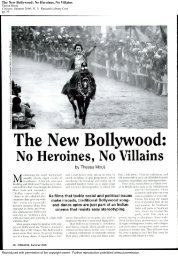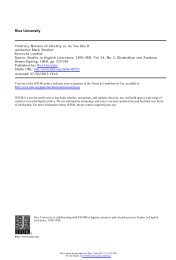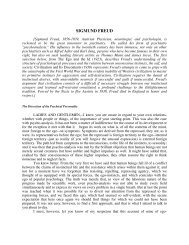Contemporary China - Yavanika
Contemporary China - Yavanika
Contemporary China - Yavanika
You also want an ePaper? Increase the reach of your titles
YUMPU automatically turns print PDFs into web optimized ePapers that Google loves.
fut:"l<br />
danced to a chant and percussion while planting<br />
the rice helds. \Vhen Communist troops entered<br />
the big cities in 1949 they were preceded by frles of<br />
dancers performing this simple work forn as a victory<br />
theme. In time yangge was applied collectively<br />
to various other types of performances that were<br />
rlpvolnrrarl frnm it<br />
During the 19th century the style of yongge<br />
prevalent in Dingxian, Hebei Province, gradually<br />
became elaborated as village perfbrnrance: 20 to 30<br />
dancers perfbrmed with a leader, male and female<br />
characters confronted each other with a question<br />
-response narrative followed by singing and dance<br />
movements extended with representational gesture.<br />
Elemental themes from village life and ethics<br />
wele introduced. A cornic character fiequently<br />
added the necessary touch of earthy humour.<br />
Drum, gong, flute and rymbals plovided musical<br />
,. ^ ^^ - -,. - : -.- ^ - L<br />
dLLUt r I Pdl<br />
lll llEll L,<br />
Two scholars, Li Jinghuan and Zhang Shiwen,<br />
conducted a governnent-sponsored freld project<br />
on the Dingxian style in 1932, afterwards publishing<br />
an anthology of plays. It was this genre of performance<br />
the Communists for.rnd so adaptable and<br />
were quick to develop for their needs. Yangge<br />
troupes proliferated. More than 30 ofthem staged<br />
performances at the 1944 Yan'an spring festival.<br />
Their repertoire included a play called The Wite-<br />
Haired CirI lBaimao nii l.<br />
Reputedly of ballad-recitative origin and based<br />
on some actual facts, the play had undergone collective<br />
revisions prior to the 1944 presentation. In<br />
1945 a new five-act version was prepared with a<br />
script and lyrics by He Jingzhr 17924- ) and Ding Yi<br />
(1,921,-). Music based on authentic folk sources<br />
was composed for it by Ma Ke (1918-76) and five<br />
colleagues. Being directed against abusive social<br />
practices long familiar to village tenant farmers, it<br />
becane a theatrical symbol of the revolutionaly<br />
cause and was constantly performed in the late<br />
1940s and 1950s. The fusion ofsong, music, chorus<br />
work and ordinary speech allied to a contemporary<br />
setting set The V\htte-HaLrcd Giri apart from either<br />
traditional Chinese or modern Western stage practices,<br />
though both had clearly offered son're inspiration.<br />
[t appealed to an audience fbr whom<br />
theatre without song and music was inconceivable<br />
and dialogue drama in the Western vcin meaningless<br />
in the context of their lifestyle.TheWtttHoired<br />
Girl was the first full-length representative ofa new<br />
40<br />
national genre naned cUU, song drama. Flexible<br />
in subject matter and musical form it was contenpolary<br />
but adaptable to regional traditions. lt was<br />
one solution to finding a middle way befween past<br />
and present, a long-standing problem of Chinese<br />
theatre.<br />
Re-establishrnent of the Nationalist capital at<br />
Nanjing in May 1946 followed Japan's defeat in<br />
1945. ln 1946 full-scale civil war broke out as the<br />
CCP began its drive for ultirnate power. Crippling<br />
inflation Ied to economic chaos and social disintegration.<br />
The plight of the universities was desperate,<br />
the mood ofintellectuals despair.<br />
In 1946 Xiong Foxi became head of the Shanghai<br />
Municipal Experimental School of Dranatic Art.<br />
Sharing the premises of a local rnuseurn and pri<br />
rnary school. Xiong's faith in theatre was natched<br />
by that ofhis students and stafI. Conbining classroom<br />
study with working experience they sustained<br />
a continuing series ofperfbrmances for the<br />
public in spite of neglible government support.<br />
Tian Han, Cao Yu and Hong Shen all taught there<br />
after the war. Xia Yen had given up playrvriting for<br />
filn wolk and Ouyang Yuqian was working fbr<br />
Hong Kong film studios. Dai Ailian, the dancer,<br />
another guest of the United States during this<br />
period, returned to set up her own school in<br />
Shanghai. ln 1949 when the Nationalist governnent<br />
left for Taiwan these key artists stayed on to<br />
work under the new governnent. It was a decision<br />
which was shared by a large proportion of people<br />
prominent in both traditional and modern theatre<br />
circles.<br />
The People's Republic 1949-91: policy<br />
and theory<br />
On 1 October 1949 the Chinese Comnunist Party<br />
(CCP) established the People's Republic of <strong>China</strong><br />
{PRC)under its Chairman Mao Zedong. In 1966 Mao<br />
Iaunched his radical Cultural Revolution in an<br />
attempt to preserve revolutionary purify. With his<br />
death in September 1976 and the fall ofthe radical<br />
'gang olfour' the following month, economic modernization<br />
soon assumed top priority in <strong>China</strong>'s<br />
poliry, and in 1981 both the Cultural Revolution<br />
and Mao's leadership from 1958 on were largely<br />
discredited.<br />
Attitudes towards theatre reflect overall CCP<br />
policy, which means that thefe have been substantial<br />
changes from period to period. However, at no<br />
tine has rhe CCp believed it<br />
cern with theatre activities al<br />
the fact of censorship has br<br />
though the extent has varied (<br />
Until 1981, the basic CCp I<br />
theatre (and other arts) were<br />
in his'Talks at the yan'an ton<br />
Art'. Mao declared there thar L<br />
ety but also influenced it as<br />
ganda, whether it intended t(<br />
theatre as representing the int<br />
another and advocated that i<br />
bourgeoisie and favour the<br />
peasants and soldiers. Elsewh<br />
the critical assimilation ofrra,<br />
theatres.<br />
In July 1950 the new gover<br />
Culture set up a Drama Re<br />
determine precisely how pra<br />
should be brought into line I<br />
traditional music dramas it re<br />
emphasized Chinese patriotis<br />
or heroism, equality betwee<br />
political prominence of womt<br />
drarnas on historical themes<br />
emphasize similar topics. On th<br />
items considered 'feudal'and r<br />
agalnst the poor were banned<br />
isms, costunes and other aspe<br />
actor's craft were retained, ref<br />
abolition of some 'unhealthy, r<br />
hero should be shown in a pos<br />
ated him before a feudal pers<br />
Kowtowing and the 'false foc<br />
Changsheng were banned. Ther<br />
of 1958 gave strong emphas<br />
forms on contemporary them(<br />
courage traditional themes. Th<br />
and early 1960s, although<br />
Stanislavski were donrinant in<br />
cles, those of Bertott Brecht als<br />
led by Huang Zuoling ofthe Sh<br />
Theatre.<br />
At a meeting of heads of CC<br />
held in April 1963, Mao's wifeJi<br />
cular distributed calling for ,thr<br />
performance of ghost plays', by<br />
any traditional nusic drama r<br />
historical item. ln mid 1964 a<br />
Opera on <strong>Contemporary</strong> Then<br />
ffi$#;lri 1


